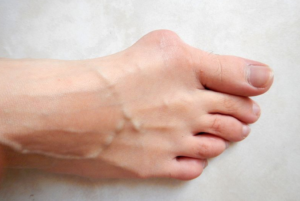What is a bunion? Do I have one?
A bunion is the painful bump on the outside base of your big toe, sometimes referred to as hallux valgus.
This joint is where the first long bone of the foot meets the next bone of the big toe. This joint is known as the metatarsophalangeal joint. Due to its location and its function to push off while you walk, bunions can often reduce the flexibility of the toe and cause continuous and worsening pain.

Bunions often develop over time. If left untreated for months to years, the normal bone structure will change, creating the bump you see on the foot and sometimes feel in your shoes! The bunion can cause further pain and deformities, if or when the big toe starts pushing against each other and causes the second or third toe to overlap. You may find it increasingly difficult to wear close toed shoes or walk due to pain.
What causes bunions? Who is more likely to get them? Can it get worse?
Anyone can get a bunion, but they tend to present in women more often.
Your genetics and lifestyle choices may influence how likely you develop bunions.
Wearing tight-fitting or high-heeled shoes may worsen bunion pain and the deformity. Sometimes, not having the appropriate arch support in your shoe may de-stabilize your foot causing the bunion deformity to worsen.
Bunion symptoms include:
• Recurring pain and tenderness; burning sensation
• Redness, inflammation, and swelling of the big toe
• Hardened skin on the bottom of the foot
• Irritated skin or calluses or corns on the bump or between the toes
• Stiffness in the big toe, pain with moving the toe up and down; popping or “cracking” of the metatarsophalangeal joint
Do I need surgery? What are the surgical options out there?
Surgery is indicated when the patient has continuous pain localized to the bunion. Bunions can be aesthetically displeasing, but your surgeon can provide conservative methods to minimize your bunion pain before discussing surgery. These include supportive insoles or custom orthotics, padding and shoe gear modifications.
There are many options to surgical treatments of bunions today. These include but are not limited to:
- Traditional open bunionectomy
- Hallux “Akin” osteotomy
- Metatarsal Osteotomy
- Minimally invasive bunionectomy
- Fusion bunionectomy
- Tarsometatarsal fusion “Lapidus”
- Metatarsophalangeal fusion
- Cheilectomy
No bunion is the same, just like no two people are the same. Depending on your bunion deformity type and severity, lifestyle, and your occupation, your surgeon will discuss the most optimal approach for the best post operative outcomes. Consult with your foot and ankle specialist about your bunion.

